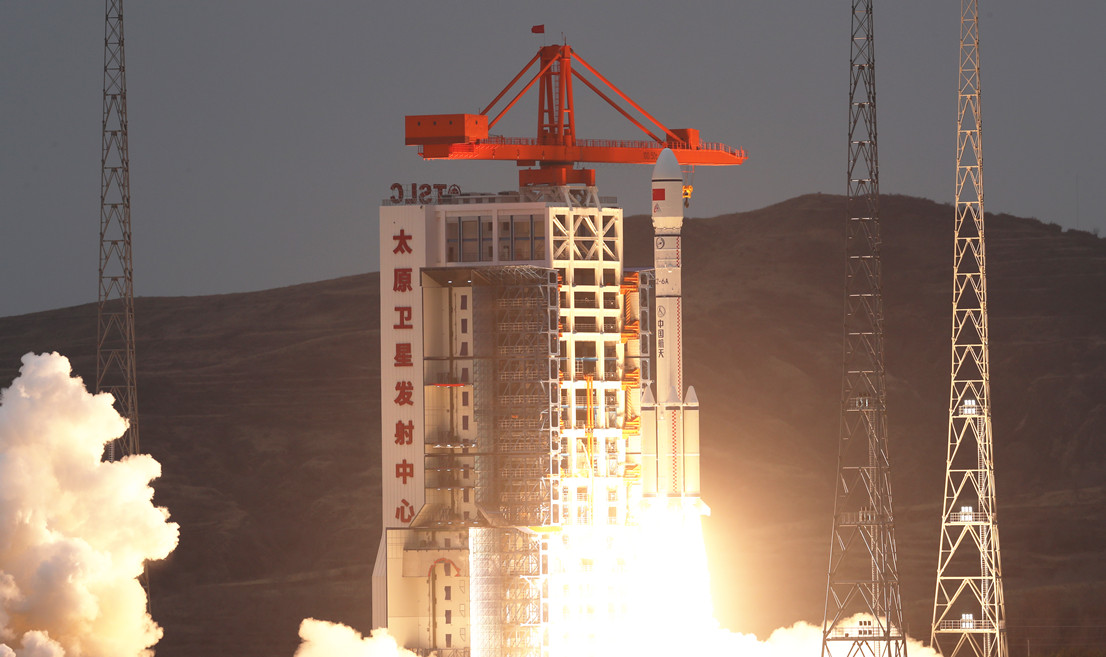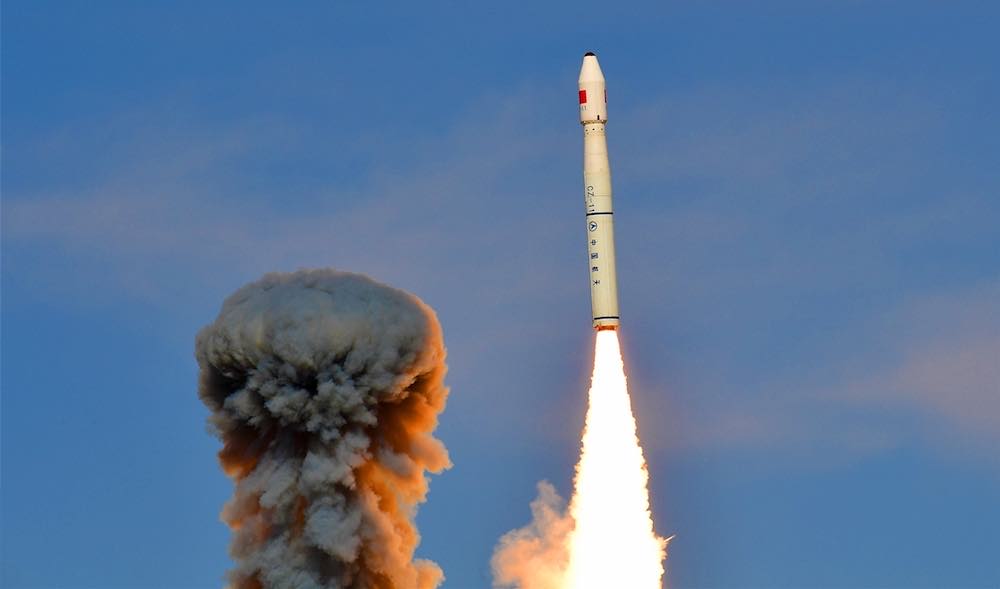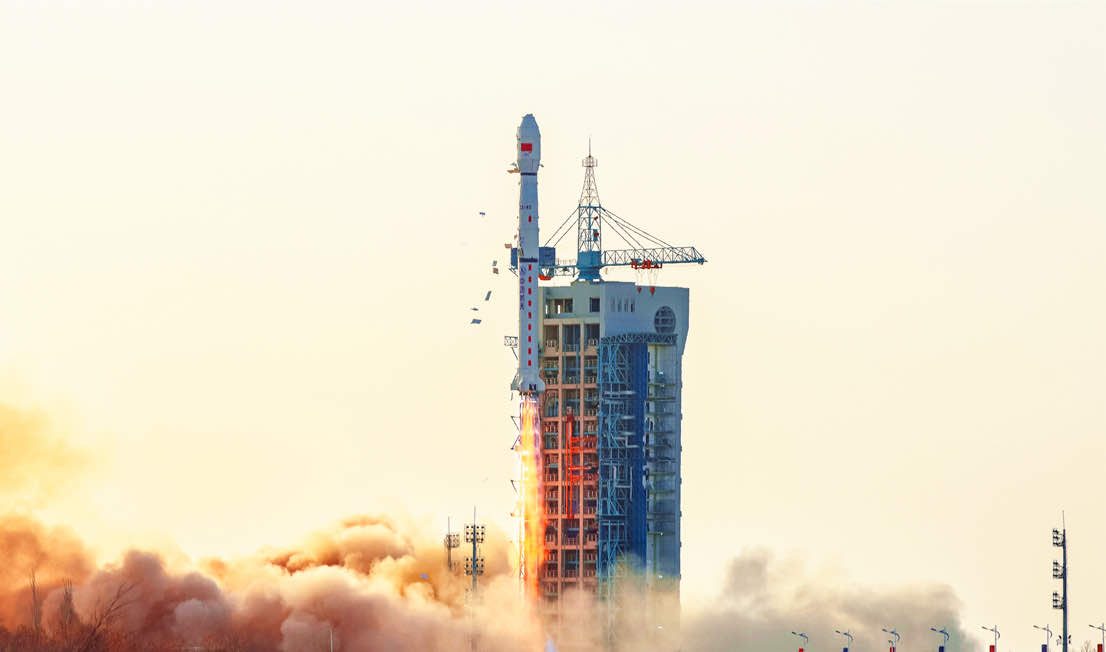Space News & Blog Articles
China launches three space missions, debuts new rocket configuration
 China’s first Long March 6A rocket, with four strap-on solid rocket boosters, lifted off March 29 from the Taiyuan launch base. Credit: CASC
China’s first Long March 6A rocket, with four strap-on solid rocket boosters, lifted off March 29 from the Taiyuan launch base. Credit: CASC
China launched three more space missions in recent weeks, debuting the country’s first rocket to be fitted with strap-on solid-fueled boosters and deploying satellites to image planet Earth and calibrate orbit prediction models, according to Chinese state media.
A new version of China’s Long March rocket family, the Long March 6A, launched for the first time March 29 with two satellites. The Long March 6A is China’s first satellite launcher to feature solid rocket boosters, a thrust configuration commonly used on U.S., European, and Japanese rockets.
The new rocket variant is designed to haul payloads up to 4 metric tons, or 8,800 pounds, into a polar sun-synchronous orbit at an altitude of 700 kilometers, or 435 miles.
The first Long March 6A lifted off at 0950 GMT (5:50 a.m. EDT) on March 29 from the Taiyuan launch base, located in Shanxi province of northern China. Liftoff occurred at 5:50 p.m. Beijing time.
The 164-foot-tall (50-meter) rocket headed south to place its two payloads into a polar orbit. U.S. military tracking data indicated the Long March 6A deployed two satellites into an orbit around 373 miles (600 kilometers) above Earth, at an inclination of 97.8 degrees to the equator, according to publicly-available U.S. military tracking data.
The Long March 6A is a modified version of China’s Long March 6 booster, which flies without any strap-on boosters. The Long March 6A debuted a stretched first stage structure, and adds a second kerosene-fueled YF-100 main engine. With the four boosters and two main engines, the Long March 6A generates more than 1.6 million pounds of thrust at liftoff.
The basic Long March 6 rocket configuration flies with a single YF-100 engine. Chinese engineers also introduced a wider second stage for the Long March 6A, supplying additional propellant for the second stage’s YF-115 engine.
The greater propellant capacity and additional thrust gives the Long March 6A a payload lift capability nearly four times that of the Long March 6 rocket.
The China Aerospace Science and Technology Corp., or CASC, declared the launch a success in a statement. CASC is China’s largest state-owned aerospace contractor, and oversees the Shanghai Academy of Spaceflight Technology, or SAST, builder of the Long March 6 and Long March 6A rocket families.
The Long March 6A rocket carried the Pujiang 2 and Tiankun 2 satellites, CASC said.
Pujiang 2, developed by SAST, will “carry out scientific test and research, land and resources survey and other tasks,” according to China’s state-run Xinhua news agency. It follows the launch of the refrigerator-sized Pujiang 1 satellite in 2015, a mission designed to promote “smart city” development in China by monitoring weather, traffic, and population density.
Tiankun 2 will demonstrate a small spacecraft bus developed by China Aerospace Science and Industry Corp. It follows a small spacecraft named Tiankun 1 launched in 2017.
 A Long March 11 rocket lifted off March 30 from the Jiuquan launch base. Credit: CASC
A Long March 11 rocket lifted off March 30 from the Jiuquan launch base. Credit: CASC
Another Chinese rocket launch March 30 carried three small satellites into orbit on a mission to survey the “atmospheric space environment” and support “orbital prediction model correction,” the Chinese government said.
The Tianping 2A, 2B, and 2C satellites launched from the Jiuquan space center on a Long March 11 rocket at 0229 GMT on March 30 (10:29 p.m. EDT on March 29). CASC reported the four-stage Long March 11 rocket released its payloads into the planned orbit, following launch at 10:29 a.m. Beijing time.
The solid-fueled Long March 11 rocket flew south from Jiuquan to place the Tianping 2 satellites into a polar orbit. U.S. military orbit data indicated the satellites were deployed at an altitude of roughly 370 miles (600 kilometers) in an orbit inclined 97.8 degrees to the equator.
The launch marked the 12th flight of a Long March 11 rocket since 2015. The Long March 11 flight history includes two launches from a sea-based platform. All of the Long March 11 flights to date have been successful.
Chinese officials disclosed few details about the Tianping 2 satellites, but they could act as passive targets to help calibrate orbit tracking sensors. China launched two Tianping 1 satellites, which officials similarly described as calibration spacecraft, on a Long March 2D rocket in 2018.
 A Long March 4C rocket lifted off with the Gaofen 3-03 satellite April 6. Credit: CASC
A Long March 4C rocket lifted off with the Gaofen 3-03 satellite April 6. Credit: CASC
A three-stage Long March 4C rocket took off April 6 with a radar imaging satellite to join China’s fleet of orbiting environmental monitoring platforms.
The Gaofen 3-03 satellite launched on a Long March 4C rocket at 2347 GMT (7:47 p.m. EDT) on April 6. The liquid-fueled launcher lifted off from the Jiuquan rocket complex in the Gobi Desert at 7:47 a.m. Beijing time.
The Long March 4C deployed the Gaofen 3-03 satellite into an orbit at an altitude of approximately 460 miles (740 kilometers) and an inclination of 98.4 degrees.
Gaofen 3-03 joins two similar Gaofen 3-class satellites launched by China in 2016 and last November.
The civilian-operated Gaofen 3-03 satellite will capture high-resolution all-weather imagery of Earth from its position in orbit. Carrying a C-band synthetic aperture radar, the craft weighs nearly 3 metric tons — about 6,500 pounds — and should help Chinese authorities better respond to natural disasters like earthquakes and floods.
The new satellite will focus on gathering imagery day and night, regardless of weather conditions. The all-weather capability of radar imaging will give officials updated information even if clouds or rain showers block the view of space-based optical cameras.
CASC has previously said the C-band radar instrument on Gaofen 3 satellites can gather information to meet needs in maritime environmental monitoring, emergency response, water conservation, weather observations, and agriculture.
The Gaofen satellites are part of the China High-resolution Earth Observation System, or CHEOS, a network of optical and radar instruments to monitor the environment. China has launched more than 40 satellites under the Gaofen name since 2013.
This email address is being protected from spambots. You need JavaScript enabled to view it. the author.
Follow Stephen Clark on Twitter: @StephenClark1.
When you subscribe to the SpaceZE News Feed, we will send you an e-mail when there are new updates on the site so you wouldn't miss them.

